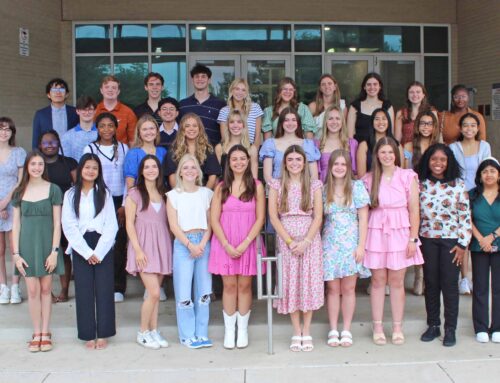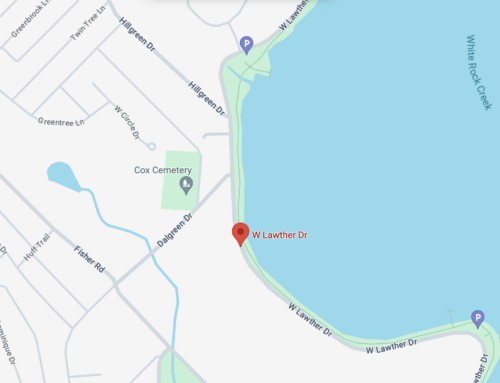For years Gina Niesman drove by the house in Lake Highlands with the incredible front yard – the yard with the towering trees and meandering flagstone paths. Then, one day, she hit the brakes.
There was a For Sale sign.
Niesman laughs about buying a house because it was attached to “that yard,” but her love of nature is evident in the quiet way she looks around at her heavily wooded neighborhood. And it was her love of nature that convinced her not to put chemicals on the ground.
“One main reason for us going toward organics was the wildlife in our area,” she says. “Squirrels, birds, raccoons. We just wanted to keep it safe so that we could enjoy them.”
“In the mornings when we sit at the table, it’s nothing to see at least 10 squirrels out playing. And our yard has never looked healthier.”
“We have two little dogs,” says Niesman’s neighbor, Fran Faccenda.
“And it’s just safer, and I feel more comfortable with it (organics). You can walk around and see these signs in some yards that say: Beware, this lawn was sprayed today by so-and-so.
“I don’t have to worry about that.”
Niesman and Faccenda are part of a growing movement toward “the natural way” in our country. It’s a movement that has its roots, literally, in our own neighborhood and one that is characteristic of attitudes common to this part of town. Our numerous old trees, White Rock Lake, the many varieties of wildlife – all these we consider held in trust for us and our families.
“There was never a question for me of whether to go organic or not,” says Eddie Poston, sitting on the front steps of the M-street stone house he shares with Melvin Baker.
“There’s a spiritual side to this in that we are stewards of the planet. Chemicals (used on lawns and gardens) seep into our groundwater, and then we drink it. I don’t think using chemicals is very good stewardship.
“Plus, having pets and having friends with children…you want them to be able to play in your yard without fear.”
The decision to go down the organic path is harder for some than others – particularly if that decision fundamentally changes the way you do business and earn your living. When Ruth Kinler of Redenta’s Garden made the decision to go 100 percent organic in 1992, she took a deep breath and “literally dumped $4,500 worth of inventory.”
“It was a major step,” Kinler says with a short laugh. “It was what my customers wanted, I knew I could succeed as a business by being totally organic – and I didn’t like using the stuff (chemicals) myself.”
And then there’s Howard / Another clue as to why the organic movement seems to be spiraling out from our part of town can be heard espousing his passionate views on WBAP each day.
If you’ve spend any amount of time listening to long-time East Dallasite J. Howard Garrett or if you use his gardening guide “Plants of the Metroplex,” you’re probably no longer startled by such flatly inflexible instructions as “DO NOT PLANT” and “If you must paint tree cuts to be able to sleep nights, use natural shellac or, better still, Lac Balsam.”
Garrett doesn’t exactly hide his opinions, and he’s almost giddy with pride over our status as the hot spot of organic gardening.
“We have more going here in organics than any other place in the United States by far,” gloats the “Doctor of Dirt”, who is equally ticked off by those he has yet to reach.
It’s an educational deal,” Garrett says. “Most people do what their peers do. They go into a store, and the extension service has said to buy Dursban or synthetic fertilizer, and it’s for sale there. And they think: Well, they wouldn’t be selling it if there was anything wrong with it.
“It’s just ignorance for the most part.”
One of Garrett’s converts who has been on both sides of the fence is neighborhood lawn care businessman Ron Hall. Thirteen years ago, Hall, a Dallas fireman, started his business to make his days off a bit more lucrative. “Ron’s Lawns” offered the usual lineup of synthetic fertilizers and might still – if it had worked.
“I was always trying to do a better job for my customers. And I had some year-round customers in Park Cities and on Swiss and… ,” Hall breaks off laughing as he tries to soft-peddle the demands of some of his high-income patrons. “It’s never green enough. The bushes don’t look good enough.
“So for those customers, I was continuously doing more. More fertilizers. More chemicals. And I noticed the more I would do, the worse the yard would get.
About that time, Hall started listening to his radio and you-know-who.
“What Howard said made sense, and it intrigued me,” Hall says. Even though he lost a third of his customers when he went organic, he has never looked back. Today, his customer base is four times what it was before the switch.
“There’s a perfect balance that’s supposed to be in our soil,” Hall says. “To correct that perfect balance is like everything else in life – there are no quick answers.
“When people go out and buy a luxury car, that car wasn’t made as quickly as a lower-end car. Your yard is the same.
“But we get mass publicity and mass advertising for products like Weed-N-Feed fertilizers. How can you make something live, and kill it at the same time? It doesn’t work. The only thing that works is that they’re selling lots of the stuff.”
Lessons learned / However profitable the quick-fix garden products have proven, there is a slow but steady movement away from the chemical approach to landscape maintenance and gardening. Since Garrett went on the air 11 years ago, more than 60 gardening centers in the Dallas-Fort Worth area have begun offering organic products exclusively. And more than 200 more offer at least some organic options.
Poston finds the ready availability of such products and information a refreshing change from his early experiences as a self-taught organic advocate.
“By the time I was out of college, ecology had started becoming a major topic and was something I latched onto right off the bat,” he says. “But I didn’t know exactly what to do. So I would go and buy books – at that time, there was not much out. Finally, there started being organic nurseries.”
Hall also praises the virtues of neighborhood organic gardening centers.
“The beauty of places like Redenta’s or Rhode’s is that they’re going to take the time to educate you as opposed to Home Depot.”
Kinler at Redenta’s says that, like Hall, she got her basic training in organics the hard way.
“A story I tell is about my first batch of roses, which were infested with aphids,” she says. “I had my employees using orthene and everything else all the chemical labels said – I couldn’t apply it myself because I was getting sick. And we couldn’t get rid of the aphids.
“One day, I brought in a shipment of ladybugs and lacewings and just spread them around. Within three days, the aphids were gone.” (Redenta’s actually now sells bags of these insects in season.)
Garrett, not surprisingly, is blunter in his assessment.
“Let me tell you – the major lies are that (1) the plant can’t tell the difference and (2) chemicals are safe and necessary,” he fumes.
Hall especially finds synthetic insectisides problematic.
“Ninety percent of insects are beneficial,” he explains, pointing out that you can’t kill the pesky 10 percent without smoking the good guys. “And for some reason, I don’t know why, the good guys seem to be more susceptible to the chemicals. And the bad ones come back and then have no natural predators left.”
Green for the green / Isn’t cost a factor for the organic gardener? Yes, Garrett, Kinler and Hall say – organic is cheaper – in the long run.
“When you first start doing the organic program, and look at an organic bag of fertilizer versus a synthetic bag, it looks like organics cost more,” Garrett says.
“But when you look at the overall program – how many times you have to fertilize, how many times you have to spray, how many sick plants you won’t have to replace, how much water you’ll save…and it gets easier every year. You have to do less and less. The long-term savings are really substantial.”
“When you use a synthetic fertilizer,” Kinler says, “they do provide nutrients to the plant for the moment, but when they’re gone, all that’s left is salt. You’re just building up salt in the soil.”
Hall says: “I don’t know anybody who’d go spread salt on their yard.” His service charges about $30 a quarter to organically treat a small front lawn, building up the soil over several years; there’s an additional fee to fertilize bed and shrubs. Costs vary by the condition and size of your yard.
According to Hall and Kinler, when you use an organic fertilizer or organic matter of some sort – like cotton seed meal – you’re building up the soil time after time with nutrients that will always be available to the plant. The only bad news, Hall says, is that organics have the potential to rob him of customers.
“That’s the beauty of organics. You can take care of your yard and never spend a dime anywhere else if you want to do it yourself. You can save your coffee grounds to fertilize your roses. You can crush up orange peel and make citrus spray to destroy your fire ants. Compost is the perfect fertilizer.”
Even if you use Ron’s Lawn, Hall admits: “Once you go organic, in all reality, in three years if we’ve done our job, and you water right and mow right – you really wouldn’t need to do anything else to your soil. You’ll have that perfect ecosystem.”
How-to / Kinler says that when she gets a newcome unfamiliar with the organic approach, she tries to keep it as simple as possible.
Fertilize with organic materials, organic compost and something like a fish emulsion-based foliar spray. Spread hardwood mulch (which breaks down into organic matter) on all bare soil to conserve water and control weeds. Use beneficial insects to control pests – although the best prevention is a healthy plant.
“If nothing else,” Kinler says, “just stop using the chemicals.”
Hall says exactly that same thing – as a last resort, do nothing.
“Chemicals destroy the humus in our clay-based soil and just make it harder and harder,” he says.
In other words, if you aren’t ready to take the organic plunge, just back off for awhile, and let nature take its course.
More simple advice – don’t rake. You’re depriving your lawn and garden of nutrients, and jamming up the City landfill.
“The City ought to make it illegal right now to send any kind of organic matter to the landfill; no homeowner should ever let any kind of leaves or grass clipping leave their property. It’s throwing money away. It’s just insane,” Garrett says.
Don’t like the way fallen leaves look? Run your lawnmower over them, and mulch them into the grass.
And try to resist pruning and fertilizing trees.
“Butchering crepe myrtles is a great example,” Garrett says. “People do that to shade trees, too, which is even worse. And then we over-fertilize them and kill the root fungus they need. I think trees grow in spite of people.
“Lakewood has got kind of an interesting environment for trees. We’ve got very shallow rock, but the soil is really good for growing trees. There are things we can grow here that won’t work further north like in Plano – trees like Lace Bark Elm, magnolias and some of the big hollies.”
Garrett also recommends focusing on planting the right plant. Some of his favorite native trees here are Texas Ash, Bur Oak, Red Oak, Cedar Elm, Native Pecan and Mexican Plum. Some very good adapted trees include Ginko, Tulip Tree, Chinese Pistachio and Silver Leaf Linden.
Dr. Joe McFarland at the Stephenville A&M Research Center agrees: “Howard Garrett is correct in his assessment of the uses of native, adapted trees, ornamentals, and other landscape plants,” he says. “A lot of food and flower plants are imports, however, so are not well adapted to our insects, diseases, environmental condition, and other stresses.”
McFarland adds another tip: When you thumb through seed catalogs, look for resistant varieties of plants for this region. Breeders have screened the varieties and identified the resistances. McFarland says that he, for example, selects tomato varieties based on the number of letters – VFNT and a lot more – and cucumber and squash varieties in part on their resistance to mildew, a leaf disease.
Also consider using drip irrigation in order to discourage plant diseases that get started on wet leaves, says the A&M researcher, who is well known in organic circles for discovering the uses of corn meal as a fungicide.
Hall agrees Mother Nature is easier to join than beat.
“When you try to work with nature, you get a lot more than when you try to constantly battle nature. Whether you believe in God or not, there is a ‘Supreme Force’ in our universe,” says Hall, who also has thoughts about why so much of the organic community can be found here.
“There seem to be a lot more people per capita in this neighborhood interested in society as a whole, and I guess that’s what it’s all about. Building community.
“Organic people are all different politically, religiously – but it seems like they are all striving to build something.”
Or, as Kinler says: “It’s easier, it’s healthier – I just decided that was what I was gonna do.”





